Understanding Diamond Sizes: Finding the Right Fit
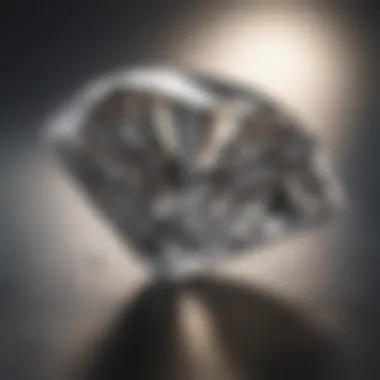
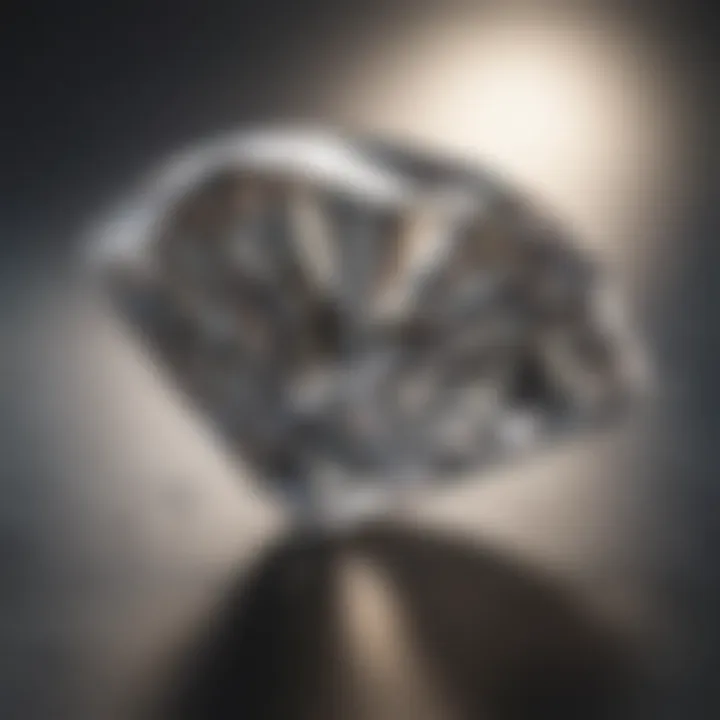
Intro
When seeking to understand what contributes to a diamond's desirability, one must engage in a nuanced discussion of its size and shape. "Good size" is subjective; it is influenced by personal taste, cultural context, and current market trends. The following sections will analyze these aspects, aiming to equip readers with knowledge that aligns with their preferences and needs.
Gemstone Overview
Definition and characteristics
A diamond is a precious gemstone renowned for its unparalleled brilliance and hardness. Composed primarily of carbon atoms arranged in a crystal lattice, diamonds are formed deep within the Earth under extreme heat and pressure over millions of years. Their clarity, cut, color, and carat weight serve as the pillars of the gemstone's quality, while the size of a diamond impacts both its visual appeal and its price on the market.
Classification of gemstones
Diamonds belong to a broader category known as gemstones, which can be classified based on various characteristics.
- Natural gemstones: Formed through natural processes over geological time.
- Synthetic gemstones: Man-made stones that mimic natural gems but differ in formation processes.
- Organic gemstones: Formed from biological processes, such as pearls and amber.
While diamonds predominantly fall under the category of natural gemstones, synthetic versions have gained popularity, presenting buyers with more options.
Properties of Gemstones
Physical properties
The physical properties of diamonds include hardness, brilliance, and fire. The Mohs scale ranks diamonds as a 10, indicating their resistance to scratching. Their optical properties enable them to refract light, creating the sparkle that many find desirable. These characteristics often determine not just the beauty but also the perceived value of a diamond.
Chemical properties
In terms of chemistry, diamonds consist of pure carbon but can contain trace elements that alter their color and quality. For example, the presence of nitrogen can lead to a yellow hue, while boron can result in blue-colored diamonds. Understanding these chemical properties can help buyers assess quality and value effectively.
"The visual and chemical attributes of a diamond directly influence its market price and buyers' perceptions."
Such insights are crucial for anyone aiming to invest in or choose a diamond for personal use.
Through this detailed overview, readers gain a better grasp of what defines a diamond's allure. The following sections will explore more specific considerations on selecting a diamond that not only looks good but also meets personal and financial expectations.
Prelims to Diamond Sizing
Understanding diamond sizing is a crucial aspect for anyone looking to purchase a diamond. Size is often one of the first things people consider when selecting a diamond, as it influences both its visual impact and perceived value. In this section, we will explore various elements that impact the size of a diamond, helping readers to appreciate how size factors into their selection process.
The importance of size lies not just in aesthetics, but also in social and cultural values associated with diamond jewelry. Many people view larger diamonds as symbols of status or affection. Understanding these implications makes it easier to choose a diamond that aligns not just with personal taste, but also with social expectations.
Also, it is essential to consider that a diamond's size is not solely defined by its carat weight. Numerous factors can distort the perception of size, such as cut, clarity, and color. Knowing how these components interplay will enrich the buyer's knowledge and ultimately lead to a more satisfactory purchase. Readers will find that size is a multifaceted topic, one that combines personal preference with conventional measures of quality.
The Importance of Size in Diamond Selection
Size plays a significant role in the selection process for a diamond. Buyers often focus on how size translates into visual appeal. A larger diamond often attracts more attention and may be viewed as more desirable. However, it is important to remember that personal preference varies widely. Some individuals may find smaller, well-cut diamonds more attractive than larger stones that lack good proportions.
A larger diamond can also significantly impact a piece of jewelry's price. Generally, diamonds increase in value exponentially with size. This means that a buyer must balance their desire for a larger stone with their budget. Thus, understanding how size correlates with both aesthetics and financial commitment is vital.
It is essential for potential buyers to prioritize their values. Is larger size more important, or should the quality of the diamond be the predominant factor? This decision underscores the complexity of diamond selection and highlights the need for informed choices in the market.
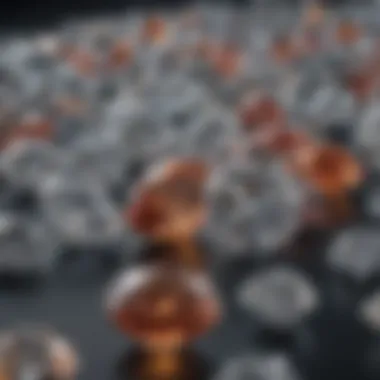
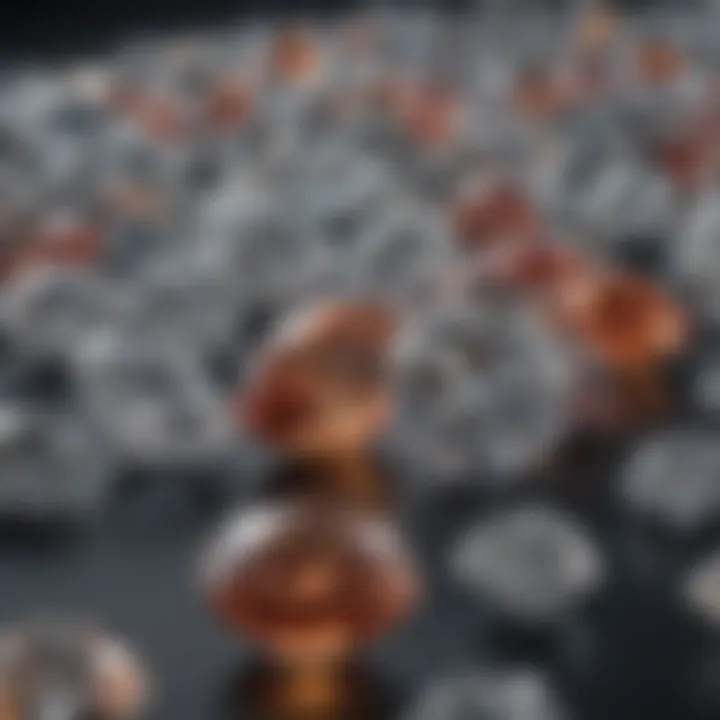
Factors Influencing Perceived Size
Perception of size can be subjective and influenced by various factors beyond carat weight. The physical appearance of a diamond can be altered by several elements:
- Cut: The cut of a diamond can greatly affect its appearance. A well-cut diamond reflects light effectively, making it look larger than its actual size.
- Shape: Different shapes can create varied perceptions of size. For example, oval diamonds often appear larger than round ones of the same carat weight.
- Color: Lighter colored diamonds often seem more substantial due to the way they reflect and refract light, especially under certain lighting conditions.
- Setting: The design of the jewelry setting can impact how a diamond's size is perceived. A proper setting can enhance the relative appearance of the diamond.
Understanding these factors can help buyers make more informed decisions when selecting a diamond. A personal assessment, combined with knowledge about how these elements interact, enhances the likelihood of finding a diamond that resonates on multiple levels.
Understanding Carat Weight
Understanding carat weight is crucial when discussing diamond sizes and their perceived value. Carat weight measures a diamond's weight, with one carat equaling 200 milligrams. This measurement plays a significant role in determining the price and desirability of a diamond. The general rule is that the greater the carat weight, the more valuable the diamond, but this is not the sole determinant of its worth.
When selecting a diamond, it is essential to consider how carat weight can represent a balance between size and overall quality. Higher carat weights often lead to larger diamonds, which is often what consumers desire. However, potential buyers should not prioritize carat weight alone. Other factors, like quality, clarity, cut, and color, also significantly influence the visual appeal and overall value of the stone.
Defining Carat Weight
Carat weight is defined as the weight measurement of gems, with diamonds being no exception. Although many assume that carat weight directly translates into size, this is not entirely accurate. For instance, two diamonds may have the same carat weight but appear different in size due to variations in cut and shape.
Here's a brief breakdown of how carat weight functions in diamond grading:
- Diamonds are weighed on precise scales, with weights displayed to two decimal places.
- The carat system originated in the carob seeds used in ancient trade as balance scales.
- A diamond's carat weight is separated into points. One carat equals 100 points, allowing precise measurements.
- More substantial diamonds are rarer, leading to higher prices.
Carat Weight vs. Visual Size
Carat weight does not exclusively determine how large a diamond appears to the eye. Factors such as the cut geometry, proportion, and overall design affect visual size. It’s possible for a one-carat diamond to look visually smaller than a 0.9-carat diamond, depending on its cut.
To understand how carat weight affects appearance, consider:
- Cut Quality: A well-cut diamond can maximize light reflection, often making it appear larger.
- Shape Preference: Round diamonds tend to appear larger than their fancy shapes, like princess or oval, even at the same carat weight.
- Setting Style: The style of the ring or setting can influence how the diamond appears; a thin band may lead to a greater perception of size.
"A diamond's appearance is a combination of its weight and the skill in which it has been cut."
In summary, while carat weight is an essential factor in understanding diamond sizes, it should not be viewed in isolation.
By considering the totality of the 4 Cs—cut, clarity, color, and carat—buyers can better assess what constitutes a good size diamond according to their preferences and needs.
Size vs. Quality: The Cs
Understanding diamond size does not solely hinge on carat weight. Instead, the overall perception of a diamond combines several elements, often referred to as the 4 Cs: Cut, Clarity, Color, and Carat. Each characteristic plays a significant role in defining a diamond’s quality and desirability. Balancing these factors is crucial, as it affects aesthetic appeal, value, and personal choice.
Cut
How Cut Affects Appearance
The cut of a diamond significantly influences its overall appearance and brilliance. A well-cut diamond can reflect light in a way that enhances its visual appeal. This is the key aspect of how cut affects appearance. The angles and proportions chosen during the cutting process determine how much light is returned to the viewer, making the diamond sparkle. A popular choice is the round brilliant cut because it maximizes light return, contributing to a vivid sparkle. However, a poorly cut diamond, regardless of its carat weight, may appear dull and less desirable.
Choosing Cut for Desired Size
When striving for a specific perceived size, the cut must be carefully considered. Some cuts, like the oval or marquise, can create the illusion of a larger size compared to round diamonds of the same carat weight. The unique feature of these fancy cuts is their elongated shape, which can trick the eye into perceiving a larger size. However, choosing a cut for size may sacrifice other qualities like brilliance, thus it's vital to find a balance.
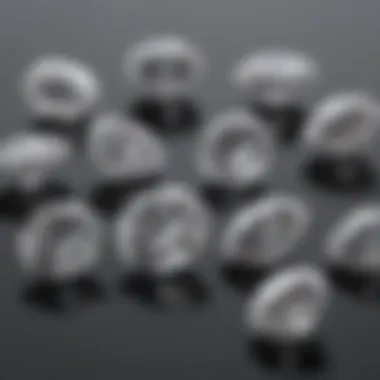
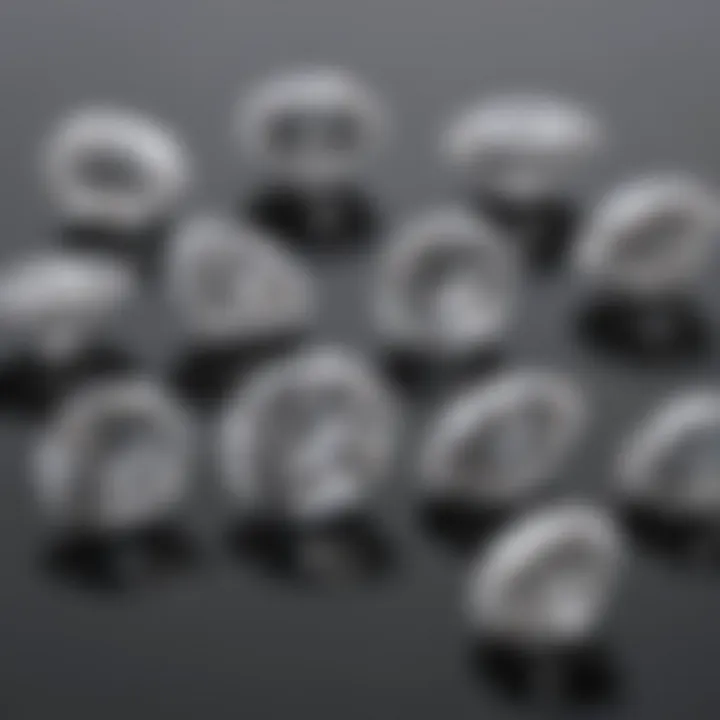
Clarity
Understanding Clarity Grades
Clarity is crucial in evaluating a diamond's quality. It refers to the presence of inclusions or blemishes. Diamonds are graded on a scale ranging from Flawless to Included. Understanding clarity grades is important because higher clarity usually translates to higher value. Moreover, inclusions may affect how light travels through the diamond, altering its sparkle. A diamond with minor clarity issues can still be visually appealing and may offer better value than a flawless stone.
Impact of Clarity on Size Perception
Clarity also affects how a diamond is perceived in terms of size. A diamond with noticeable inclusions may appear smaller, even if it technically has a higher carat weight. This is because the eye may focus on flaws rather than the overall piece. Thus, while selecting a diamond, it is beneficial to consider how clarity impacts its visual size, alongside how much you’re willing to prioritize quality over size.
Color
Color Grading Scale
The color of a diamond is assessed on a grading scale from D (colorless) to Z (light yellow). A colorless diamond can look larger compared to one with noticeable tint. The color grading scale is essential because the right balance between size and color can significantly impact the aesthetic appeal and value of a diamond.
Color's Influence on Size Appearance
The influence of color on size appearance is overlooked frequently. A diamond with a slight yellow hue may appear smaller than a whiter stone of the same carat. This occurs because the yellow undertones draw attention away from its overall size. In light of this, a buyer might opt for a diamond that balances both quality and a visually appealing appearance, especially if size is a concern.
Carat
Understanding the Trade-off
Carat weight is straightforward but involves trade-offs with other Cs. A high carat weight typically implies greater size; however, accompanying quality may decline. Understanding the trade-off is essential for making informed choices. A two-carat diamond of low quality might not have the same appeal or resale value as a one-carat diamond that excels in cut, color, and clarity.
Balancing Size and Quality
Balancing size and quality in diamond selection is a complex challenge. One must carefully consider how each of the 4 Cs interrelates. Opting for a larger diamond may not yield the best overall experience. Instead, focusing on the overall quality of the diamond, even if that means choosing a smaller size, can often lead to a more satisfying outcome.
"In the world of diamonds, size is not everything. Quality, after all, is paramount."
In summary, a good size diamond is not merely about its carat weight. The interplay between Cut, Clarity, Color, and Carat significantly influences both visual appeal and value.
Choosing the Right Size
Choosing the right size for a diamond is crucial in determining not only its aesthetic appeal but also its overall value. Size affects how a diamond is perceived, and this perception is shaped by multiple factors. Buyers must consider personal tastes, lifestyles, and cultural norms. This understanding can lead to more satisfactory selections, fitting both emotional and practical needs.
Personal Preferences
Personal preferences play a significant role when selecting a diamond size. Each individual has unique tastes, making it essential to understand what appeals to you. Some may prefer larger stones as a statement of elegance, while others might favor smaller, more subtle designs. When assessing preferences, think about factors like your style, color choices, and the settings you find appealing.
Furthermore, consider how a diamond's size communicates your personality and values. A larger diamond may convey a sense of luxury, but a carefully chosen smaller stone can reflect sophistication and thoughtfulness. Collectors often appreciate variance in sizes based on rarity and unique characteristics. Choosing the right size based on personal preference ensures that the diamond chosen is more than just a piece of jewelry; it becomes a meaningful symbol.
Lifestyle Considerations
Lifestyle is another vital consideration when selecting the right diamond size. An active person may need a smaller or lower-set diamond to avoid potential damage and ensure comfort. Conversely, someone with a less active life may opt for a larger stone, willing to embrace potential fragility for the sake of beauty.
Additional factors also come into play. For instance, those in professions involving hands-on work may prioritize durability and wearability in their selection. A larger diamond, while visually stunning, might not suit a busy lifestyle. Evaluating how the diamond will be worn in daily life is essential for making a well-informed choice. This leads to a balance between beauty and practicality that suits the buyer's individual needs.
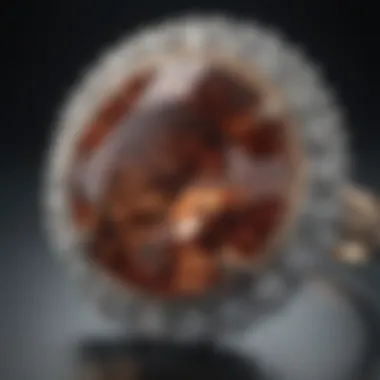
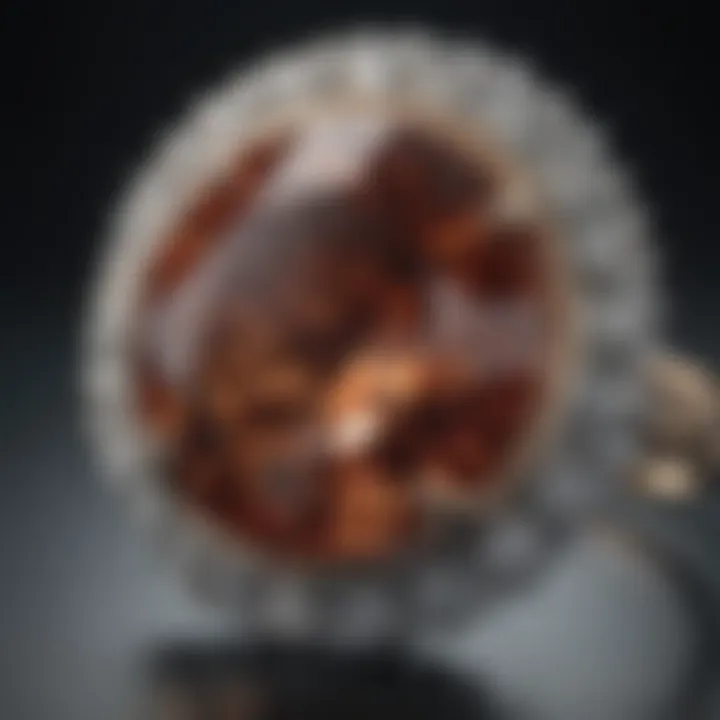
Cultural Influences on Size Preferences
Cultural influences heavily influence perceptions of diamond size. In various cultures, diamond size can symbolize different meanings, roles, and values. For example, in Western societies, larger diamonds are often associated with wealth and status, making them a popular choice for engagement rings. However, in certain cultures, modesty may be prized, and smaller stones are preferred.
Understanding these cultural nuances can help buyers navigate their choices. It is essential to appreciate the cultural context of a diamond's size and what it may signify within a specific community. Making a choice aligned with personal beliefs while respecting these cultural subtleties ensures that the purchase is meaningful beyond mere aesthetics.
"A diamond is a representation of personal significance. Size is subjective and context matters."
Market Trends in Diamond Sizing
Understanding the market trends in diamond sizing provides insights into what consumers prefer today and how these preferences have evolved. This section highlights current preferences and historical changes that have shaped the diamond market. By analyzing these factors, potential buyers can make better decisions in selecting a diamond that appeals to their taste and suits market standards.
Current Market Preferences
Contemporary preferences in diamond sizing reflect a mix of tradition and modern aesthetics. Nowadays, many consumers favor larger carat sizes, often perceiving them as more valuable. Research indicates that diamonds around one to two carats tend to be the most popular, as they strike a balance between size and affordability. Factors influencing current preferences include:
- Celebrity Influence: High-profile engagements often set trends, making larger diamonds more desirable.
- Social Media: Platforms like Instagram and Pinterest allow users to showcase their diamond rings, which influences public perception of size.
- Sustainability Awareness: There is a notable shift toward ethically sourced diamonds, impacting size choices as consumers seek sustainable options even at smaller carat weights.
The ongoing trend emphasizes individual choice, with varied preferences based on personal values rather than strictly adhering to long-standing norms.
Historical Changes in Preferences
The evolution of market trends around diamond sizes has seen distinct phases influenced by cultural shifts and economic factors. In the early 20th century, diamonds were primarily symbols of wealth and status, with higher carat weights dominating the market. As society evolved, so did preferences:
- Post-War Era: In the 1950s, smaller diamonds became more acceptable due to changing social values, with a focus on practicality.
- 1980s and 1990s Boom: Economic prosperity led to a resurgence in demand for larger diamonds, changing the standards of what was considered an ideal size.
- Shift Toward Customization: More recently, the focus has expanded to include unique cuts and shapes. Consumers began valuing distinct aesthetics over simply larger sizes.
This analysis of historical trends provides context for current market preferences. Recognizing these shifts can guide buyers in selecting diamonds that not only fit today's aesthetics but may also hold value in the future.
Understanding the dynamics of market trends is essential for both buyers and sellers to navigate the intricate world of diamond sizing effectively.
Ending: Defining a Good Size Diamond
In the realm of diamonds, sizing plays a pivotal role in both aesthetic and economic value. This article has dissected the many facets influencing what constitutes a ‘good size’ diamond. By understanding the interconnected elements such as carat weight, personal preferences, cultural contexts, and market trends, individuals can make enlightened choices.
Choosing a diamond involves an intricate balance. Finding that equilibrium between size and quality is essential. Opting for a larger diamond may sometimes mean compromising on other important factors like clarity and cut. Each aspect has its significance and contributes to the overall appearance and perceived value of the stone.
Balancing Size and Quality
When contemplating a diamond purchase, the interplay between size and quality must be understood. The term ‘good size’ is subjective and varies from one person to another. What one individual regards as an ideal size, another may view differently based on personal taste and values. In practical terms, larger diamonds tend to command higher prices, but size should not eclipse the importance of quality characteristics.
- Clarity: The presence of inclusions may detract from the perceived beauty of a diamond. A smaller, flawless diamond can sometimes appear more captivating than a larger stone with visible imperfections.
- Cut: This heavily impacts how a diamond interacts with light. A well-cut, smaller diamond may exhibit brilliance, fire, and scintillation, creating visual appeal despite its size.
Finding a diamond that meets both size expectations and quality standards is essential for a satisfactory purchase experience.
Making Informed Decisions
Decisions made in the diamond market should be grounded in solid information and understanding. The considerations surrounding carat weight, cut quality, clarity ratings, and color grading create a labyrinth of choices. It is important to gain insights into these aspects. Doing research can prevent costly mistakes.
Factors to consider when making a decision include:
- Personal preferences: Grasping one’s desires and needs is fundamental. It can guide towards certain styles or sizes.
- Budget: Defining a financial parameter before shopping can streamline the decision-making process.
- Trends: Staying updated on market preferences may provide insights into what styles or sizes are currently trending.
An informed decision ensures satisfaction long after the purchase. Engaging deeply with available resources, seeking professional opinions, and considering individual values can collectively lead to a worthwhile investment in a diamond that resonates personally.
"Understanding the size and quality dynamics of diamonds can elevate the entire purchasing experience from a mere transaction to an informed decision-making journey."



